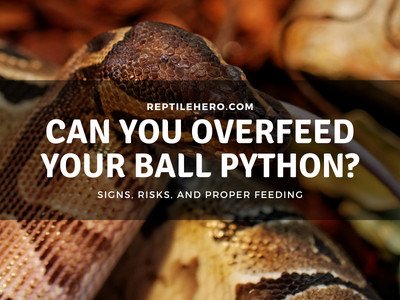Breeding Ball Pythons as a Business (Is It Profitable?)
Breeding ball pythons for profit may have gone into your mind. You may even see popular reptile breeders showing off their new morph projects. But can you really turn ball python breeding into a lucrative business?
In general, breeding ball pythons can produce revenue for the owner but making a large profit out of it will vary based on different aspects. Before starting a ball python breeding business, keepers must consider investment, revenue, location, breeding, and maintenance.
Ball python breeding can be done as a hobby alongside ball python keeping. But what if you take it seriously? Can you make a living out of breeding ball pythons? Learn more about this as you read below!
Is a Ball Python Breeding Business Profitable?
As a whole, the ball python breeding business can be profitable but this is not always the case. Some breeders have had success with it and turned their hobby into a full-time business while others had bad breeding seasons.
The most common ball python breeders are small-scale which are the ones that make their hobby a self-sustainable one. This means that they have other, more stable streams of income and only breed ball pythons for extra income.
Small-scale breeders use the income they receive from ball python breeding to sustain their hobby of collecting more and more ball python morphs. Some small-scale breeders make 2,000 dollars per month with around 15-20 breeding females.
But there are also some big-scale breeders that have invested a lot of money into this hobby to turn it into a business. They can produce thousands of baby snakes per year.
More often than not, they run their business operations in a spacious warehouse with several employees to maintain such quantities of snakes.
5 Factors to Consider Before Starting a Ball Python Breeding Business
In general, breeding ball pythons for profits has the potential to grow. But before venturing into the ball python business, some factors to look out for are 1) investment, 2) revenue, 3) location, 4) breeding, and 5) maintenance.
If you think you can cater to all of these factors, then you have a great chance of having a successful ball python breeding business.
1. Investment
In general, the initial investment will be one of the most important factors to consider in starting a ball python breeding business. Basic things to invest in include ball python pairs, incubators, miscellaneous equipment, feeders, substrate, and electricity.
| Investments | Estimated Cost (USD) |
| Breeding pair | 400 |
| Incubator (DIY) | 150 |
| Large plastic tubs | 40 |
| Electricity for heating | 40 |
| Substrate | 30 |
| Frozen feeders | 20 |
| Gram scale | 10 |
| Estimated total | 700 |
The most flexible investment in the table above is the breeding pair/s. You can get more ball pythons, get younger ones, or get higher-end morphs. So your costs for this will depend greatly on what you are willing to invest in such a business.
2. Revenue
Revenue in ball python breeding is not guaranteed but will often come if there is a successful clutch of eggs. The amount of revenue also varies on the value of morphs produced.
Since ball pythons can only produce eggs once a year, there is only one chance to have a successful breeding season. With clutch sizes varying from 1-12 eggs, the revenue is not always guaranteed.
For example, if you breed a 400-dollar pair of ball pythons that can produce babies worth 50-100 bucks, you can have a revenue averaging 300-500 bucks from a successful clutch.
3. Location
The location can affect many factors in breeding ball pythons. Factors like 1) market state, 2) legal requirements, and 3) husbandry costs are closely relevant to this aspect.
1. Market state
The ball python market is different in each state and city. The supply and demand of ball pythons, feeders, and equipment can vary depending on the location.
Some places have higher prices due to permits that are required for ball python keepers and breeders. The supply of ball python feeders and equipment can also vary widely depending on the location.
I have a friend who is located in the Philippines where ball python prices there are much higher due to the requirement of permits to keep and breed exotic animals. He also stated that the black market is common, especially in selling exotic pets.
2. Legal Requirements
Hawaii is one state in the USA where keeping ball pythons and most snakes are banned. The HRS Chapter 150A is essential to protect endemic wildlife from possible invasive predators like snakes.
The state of New York also prohibits the keeping of such animals. The ENV section 11-0103 and 11-0511 is the law for the state of New York stating that most snakes, like a ball python are prohibited to keep and sell.
As an example of licensing, Florida strictly requires permits like Class III PPNC permit for keeping and Class III ESC permit for breeding/selling ball pythons.
The PPNC permit is free and expires in 2 years while the ESC is 50 bucks per year and needs a yearly renewal.
Furthermore, ball pythons can be illegal in some countries around the world. Countries like Singapore, Spain, Australia, etc. have banned keeping ball pythons. Breeding ball pythons can also require an additional permit depending on your location.
3. Husbandry Costs
Ball python husbandry varies depending on the location. Those who live in tropical climates may have an option not to use heating and humidity tools. While keepers that are in colder, dryer climates will likely need to set up heating and humidity devices.
Using a heating/cooling system will concur additional electricity costs especially if it is operating throughout the day. The estimated cost per month can be around 50 dollars and above.
4. Breeding
Ball pythons are relatively easy to breed but successful ovulation can vary depending on the female. In regards to mating, ball pythons of the right size have a high chance of locking when bred together. More specifically, 1,500-gram females and 600-gram males are the recommended weights for breeding pairs.

The requirement for a breeding pair must have a good body form and be 1,500 grams for females and 600 grams for males. Females typically reach this size in about 3 years while males can reach breeding size in about 1-2 years.
Ball pythons’ breeding season is from September to December. After being in peak condition, you can put a female and male ball python together for around 3 days while checking daily.
If you see them locking tails, it means that they are mating. After 3 days separate them. Then after one week, you can pair the male with another female. I recommend breeding 1 male to 3-4 females per breeding season.
After a month, you can pair the male and female again and repeat the process for around 4-5 months. Stop pairing the female ball python if it shows signs of ovulation.
After successful ovulation, a female will then lay eggs that will hatch in about 60 days or more depending on their incubation temperature [1]. You can cut an egg when a baby has peeked out of the shell to ensure that they are safe.
>> Learn more about whether or not you should cut ball python eggs in our article about cutting ball python eggs
5. Maintenance
Ball pythons are one of the easiest snakes to care for. They can be cleaned and fed once a week. But in keeping and producing many snakes, the amount of time and money spent on maintenance will increase significantly.
If you are starting small as a ball python breeder, maintenance will be easy but it will get harder as more and more snakes are added to your collection.
But the maintenance is simple, consisting of spot cleaning, refilling water dishes, and the occasional substrate change and feeding. I also suggest monitoring the heat and humidity levels to ensure the right levels for your snakes—use thermometers and hygrometers.
Challenges in Running a Ball Python Breeding Business
Some challenges that a new ball python breeder should expect are 1) unsuccessful seasons, 2) illnesses, 3) competitors, 4) profit, and 5) selling.
1. Unsuccessful Seasons
In general, breeding ball pythons can sometimes be unproductive and the number of eggs or the kind of morphs cannot be predicted and controlled.
There will be seasons where a female won’t ovulate at all despite having a successful mating. There will be times when there are few eggs or there will be infertile eggs (slugs).
One way to have a better breeding season is to condition your breeding pairs. Even though the minimum male and female size is 600 and 1,500 grams, I recommend conditioning the pair to be 800 and 2,000 grams and above.
At these weights, there is a higher chance of producing a larger clutch and healthier eggs. The mating cycle can also go more smoothly when the pairs are at peak condition.
2. Illnesses
There are ball python illnesses that can spread to multiple snakes living in a small vicinity like a room. Diseases like mouth rot, Nido virus, and parasitic infestations are some of the most common that can infect other snakes.
In treating a ball python with respiratory disease, it is important to quarantine them first and then take consult a veterinarian for first aid measures [2].
Conversely, mite infestations can be treated with a simple soak in water or spraying with a reptile spray if spotted earlier on. So I suggest making sure to deeply clean enclosures near the infected snake and replace the beddings in them [3].
3. Competitors
The ball python market keeps growing as time passes by, which means that the number of competitors also increases. From keepers turned breeders to small-scale breeders turned big-scale breeders, business competition will always be there.
The amount of competition will also depend on how popular ball pythons are in various locations. Some states have strict laws which lead to fewer legal breeders and can lead to the popularity of the black market for ball pythons.
This means, in some cases, you won’t just compete with legal breeders, but also with illegal breeders that price their hatchlings very cheaply to attract more buyers.
4. Profit
Having profit in breeding ball pythons depends on the morph and the clutch size of breeders. In order to gain profit, ball python breeders must take into consideration how passionate and serious they are to make it into a business.
Breeding ball pythons will not make you quick and easy money. Like a normal business, putting in the minimum amount and not upgrading your morphs, equipment, etc. will not make you a sizeable profit besides the minimal to moderate revenue you could get.
Most large-scale ball python breeders have dedicated all of their time and a lot of money in order to gain good profit in breeding and selling ball pythons. Most of them have 5-20 years of experience and most started small.
5. Selling
Once the hatchlings are produced, selling them is another challenge. Common morphs are typically saturated in the market which makes them harder to sell than mid and high-end morphs.
Even if you are breeding high-value ball python morphs, chances are, you are still going to get common morphs in your clutch depending on the genes.
So depending on the number of ball pythons, you can maintain, you may have a problem with having too many snakes to care for which can lead to more expenses rather than revenue or profit.
5 Tips for Starting a Ball Python Breeding Business
Some tips that can be useful to new breeders are 1) quality over quantity, 2) organized plan, 3) breeding feeders, 4) proper pricing, and 5) knowing buyers.
1. Quality Over Quantity
It is recommended to start breeding a ball python pair with one good quality morph. Potential revenues produced by higher-end morphs can be higher than those produced by common ball python morphs.
If you are just starting out in breeding ball pythons, I recommend buying a “powerhouse male.” These males are ball pythons with a higher value morph and will be breeding with more than one female.
For example, you can purchase 2 or 3 single morph breeder females for about 500 bucks. A single morph ball python has only one visible mutation and they often cost less compared to those with multiple morphs.
I recommend ball python morphs like pastels, pinstripes, leopards, etc. I also suggest getting females weighing 2,000 grams or higher to have a higher chance of getting higher quality and quantity of eggs.
What I recommend doing is to invest in a male that has multiple genes which can be worth the same price or more.
For powerhouse males, I suggest picking a 3-4 gene ball python with good recessive and heterozygous genes. I recommend looking into morphs like a clown, bamboo, and piebald. I also recommend buying males that are 700 grams and above.
So if you invest a thousand bucks following the process above, you can get an estimated revenue of around 1,000-3,000 dollars in one year of a successful breeding season. This has a higher chance when pairing bigger and healthier ball pythons.
Considering you pair up ball pythons with the minimum size, it can possibly take two years to make the same amount of revenue.
The first year might be unsuccessful or have only 1-3 eggs, but the second year can be promising because the pairs might grow and lay an increase in the quantity and size of eggs.
>> Learn more about ball python morphs to be wary of in our article about ball python morphs with problems
2. Organized Plan
For a ball python breeding business, organizing plans and schedules is a great way to avoid making mistakes. Some aspects to organize are feeding schedules, breeding cycles, and incubating time.
I recommend having a single feeding day for all your ball pythons so you can have an easier time organizing snakes to feed and snakes that have eaten.
Taking note of breeding cycles and incubation time can also prevent mistakes like mispairing breeder ball pythons and immature cutting of eggs.
3. Breeding Feeders
Breeding feeders can save a ball python breeder a lot of money compared to buying frozen ones monthly. It is recommended to have at least a pair of rats per ball python.
Considering you have 10 adult ball pythons, you can get 20 adult rat pairs for breeding and 40 medium-sized rats as feeders for 2 months. Those 20 pairs can each produce 8-22 babies per month.
The baby rats will grow into an adult within 2 months. So when starting a ball python breeding business, I recommend establishing a good rack system for breeding rats.
Considering long-term costs, the sustainability of breeding your own rats is better than buying frozen ones per month. You also don’t need to worry about feeders getting out of stock if you have efficiently bred them yourself.
>> Learn more about rodent feeders in our article about feeding mice/rats to ball pythons
4. Proper Pricing
In general, pricing ball pythons can be done by researching the average price of snakes from trusted selling sites like the Morph Market and craigslist.
Pricing a ball python too much can also discourage buyers especially if they saw cheaper pricing from your competitors.
If you are selling in a reptile show or expo, I suggest looking at other sellers’ prices and matching them, especially for popular morphs.
Drastically lowering your own retail price may lead to a low profit and a bad relationship with other breeders.
When you are starting out in this business, having good connections with other breeders can help you with more knowledge of breeding and morphs of ball pythons.
Pro Tip: When selling ball pythons online, it is recommended to showcase all the good qualities of the snake clearly. Most of the time, potential buyers will skip your post if you produce a bad-quality photo.
5. Knowing Buyers
Knowing whether a buyer is a breeder or a regular keeper can be essential in gauging what aspects they need help in. With a good customer base, a new ball python breeder can get a good reputation.
If your buyer is new to the hobby, you can give them tips on husbandry or recommend some beginner-friendly morphs. A good reputation can gain you a lot of loyal buyers and connections with bigger-scale breeders.
You can also get recommendations from another breeder you have good relations with. If they do not have a morph that you have, they can even refer a potential customer to you.
Further Questions
Are ball pythons expensive to take care of?
Ball pythons are not expensive to take care of. They generally eat once a week and they do not need additional equipment besides a hide, water bowl, and a substrate. Those who live in warmer, humid climates may not use heating and humidity tools, while those in colder, dryer climates will likely need to set up heating and humidity devices.
Can you breed any morph together?
There are some ball python morphs that cannot be bred together. Morphs like spider ball pythons cannot be bred to another spider morph. Some morph combinations can cause severe wobbles and even death to the ball python.
Can you leave the ball python eggs to the mother?
Maternal incubation of ball pythons can be done in captivity. However, most breeders chose to incubate their eggs with an incubator to efficiently control the different parameters required in hatching a ball python egg like humidity and temperature.
Summary of Does Breeding Ball Pythons be Profitable?
In general, breeding ball pythons for profit can have the potential to grow. Before venturing into the ball python business, some factors to look out for are investment, revenue, location, breeding, and maintenance.
Some challenges that a new ball python breeder should expect are unsuccessful seasons, illnesses, competitors, profit, and selling.
Tips that can be useful to new breeders are including keeping the following in mind: quality over quantity, organized plan, breeding feeders, proper pricing, and knowing buyers.
Resources
[2] https://www.msdvetmanual.com/all-other-pets/reptiles/disorders-and-diseases-of-reptiles
[3] http://denardo.lab.asu.edu/publications/ARAVsnakemites.pdf






